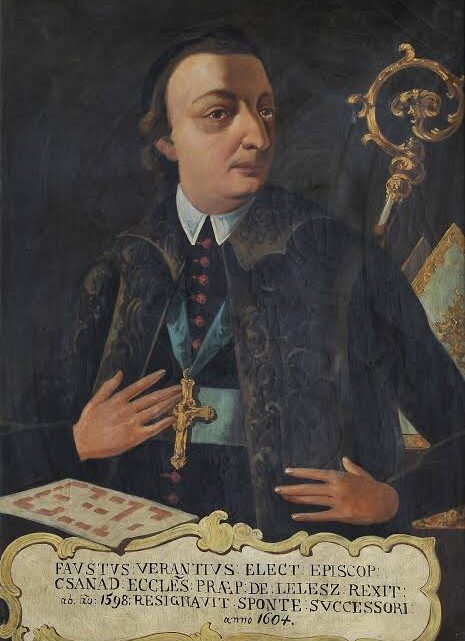
Fausto Veranzio Biography: Age, Net Worth, Siblings, Parents, Height, Children, Wife, Books, Cause of Death
Faust Vrančić was a Croatian polymath whose contributions spanned various fields, including invention, linguistics, and diplomacy.
He is best known for his innovative designs and works that reflect the intellectual spirit of the Renaissance.
Trending Now!!:
Vrančić gained recognition primarily for conceptualizing one of the earliest parachute designs, which he detailed in his seminal work “Machinae Novae.”
His diverse interests and accomplishments made him a significant European science and culture figure, influencing future inventors and scholars.
Profile
- Full name: Faust Vrančić
- Nickname: Faustus Verantius
- Date of birth: 1551
- Age as of 2024: 473 years (posthumously)
- Gender: Male
- Place of birth: Šibenik, Croatia
- Nationality: Croatian
- Profession: Inventor, linguist, diplomat
- Height: N/A
- Parents: Michele Veranzio and Katarina Berislavić
- Siblings: N/A
- Spouse: N/A
- Children: Alba Rosa Vrančić
- Relationship status: N/A
- Religion: N/A
- Ethnicity: Croatian
- Net worth: $5 million
Early Life and Education
Faust Vrančić is now deceased at 473, having been born in 1551 in Šibenik, a coastal town in Croatia. His family belonged to the nobility, which afforded him a quality education and exposure to influential thinkers of his time. His father was a diplomat, which likely contributed to Vrančić’s early understanding of politics and languages.
Growing up in an environment rich in cultural and intellectual pursuits, Vrančić was influenced by his uncle, who was an archbishop and a prominent humanist.
This familial connection provided him with opportunities to engage with the ideas circulating during the Renaissance. He pursued higher education in various locations, including Hungary, Padua, and Venice.
Vrančić exhibited proficiency in multiple languages, including Latin, Italian, Croatian, and Hungarian. This linguistic skill set would later aid him in creating one of the first multilingual dictionaries.
Personal Life
Faust Vrančić married Marija Vrančić and had one known daughter, Alba Rosa Vrančić. In his will, dated June 12, 1615, Faust Vrančić made provisions for his family members, including his daughter Alba-Roza and mother Katarina. He also ensured that the male descendants of his brother Kažimir would continue the Vrančić lineage.
Career
Faust Vrančić’s career encompassed various roles showcasing his intellectual versatility. He served as a secretary to Rudolf II, Holy Roman Emperor, from 1581 to 1594.
In this capacity, he interacted with many leading intellectuals and scientists. His position at the court allowed him to engage with contemporary scientific thought and participate in significant cultural exchanges.
One of Vrančić’s most notable contributions came with the publication of “Machinae Novae” in 1595. This work detailed numerous inventions and concepts that were remarkably advanced for their time.
The book included illustrations and explanations for devices such as bridges, cranes, and the parachute concept known as “Homo Volans.” The latter demonstrated his understanding of aerodynamics long before modern principles were established.
In addition to his engineering feats, Vrančić made substantial contributions to linguistics. He published a multilingual dictionary that significantly impacted Croatian and Hungarian lexicography.
This dictionary served as an essential resource for scholars and officials navigating the complexities of language during a time marked by political fragmentation and cultural diversity.
Vrančić’s diverse interests also led him to explore philosophy and ethics. His writings often reflected on the nature of knowledge and its application to society’s practical problems. His ability to synthesize knowledge from various fields exemplified the Renaissance ideal of a well-rounded scholar.
Net worth
Faust Vrančić’s net worth is not quantifiable due to the historical context of his life. Although, estimates suggest he was worth at least $5 million. His wealth would have been derived from his noble background and positions held within the court of Rudolf II. The nature of financial records from the 16th century makes it challenging to assess individual net worth accurately.
Death
Faust Vrančić passed away on February 27, 1617, in Venice. Following his death, he was buried on the island of Prvić at his request—an indication of his deep connection to the region where he spent much of his life. His burial site is located within a church on the island, where he remains a figure of local historical significance.
Controversy
Throughout history, Faust Vrančić has been associated with various controversies primarily due to the nature of some of his inventions and their misattributions. One significant point of contention involves the design of the parachute.
While Vrančić is credited with one of the earliest illustrations of a functional parachute in “Machinae Novae,” similar designs by Leonardo da Vinci often overshadow him. This has led to debates among historians regarding rightful credit for particular inventions during the Renaissance era.
Moreover, Vrančić’s work as a linguist has sparked discussions about linguistic ownership and cultural appropriation. His multilingual dictionary aimed to unify various linguistic groups against common threats like Ottoman incursions but raised questions about cultural representation among different ethnicities within Croatia and Hungary.
Social Media
- N/A
Books
- Machinae Novae (1595)
- Dictionarium (Multilingual dictionary)
NOTICE!! NOTICE!! NOTICE!!
DISCLAIMER!! : Every Biography and Content Published On TheCityCeleb are For Knowledge Reason. Don't Hesitate to Reach Out for Any Correction || Suggestion || Copyright!!CORRECT@thecityceleb.com


